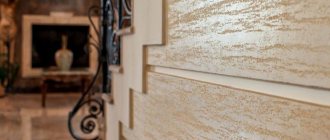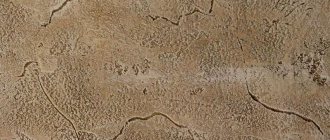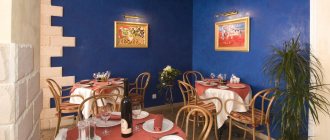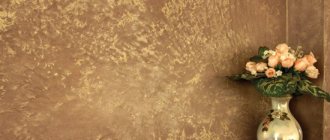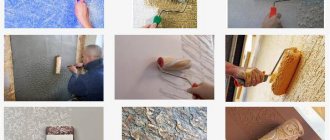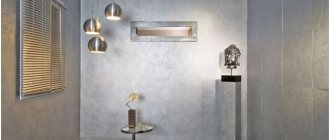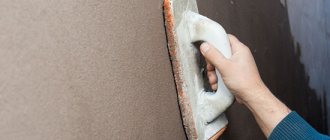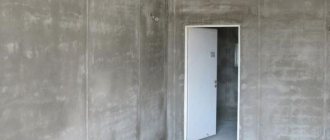Antique plaster is a decorative material that makes it possible to recreate the atmosphere of the past and make the interior more noble and aristocratic. The material is widely used in the arrangement of private houses, apartments, as well as for finishing restaurants, hotels, and other public buildings.
On the wall, plaster with an antique effect looks shabby and rough to the touch. It seems that the coating has changed its texture as a result of natural aging.
Features of antique plaster
Plaster of the old texture is used both for finishing facades and for performing work inside buildings. Walls finished with antique plaster are fire resistant. After drying, the applied decorative mixture forms a film on the surface, which ensures high performance characteristics of the coating and its resistance to mechanical stress. The versatility of the plaster composition lies in the fact that due to the components included in the composition, the effect of cracking and abrasions is created, which hides defects on the walls and gives the room a “vintage” look. In addition, this plaster:
- fits perfectly into an interior decorated in various styles: classic, baroque, empire, hi-tech, retro, modern, minimalism and others;
- suitable for decorating walls in dry rooms and rooms with high humidity;
- made from environmentally friendly materials, therefore does not cause allergies, can be used in children's rooms;
- is easy to maintain and can be easily cleaned from dust using detergents that do not contain abrasive materials and solvents;
- is resistant to mechanical damage, abrasion, and precipitation;
- can have different fillings and be applied to any primed base: chipboard, fiberboard, plasterboard, wood, concrete, stone and other surfaces.
Applying antique plaster is a rather complex process, so it is better to entrust the work to a professional craftsman. The final result will depend not only on the quality of the plaster mixture, but also on the skill of the specialist.
Options for bricks that are subject to artificial aging
Decorative materials that will help maximize the aging of the wall are listed below. We invite you to take a closer look at their features.
Clinker
Clinker brick is very similar to the real thing, so its correct laying will ideally create an imitation. This material is well suited for wall decoration both indoors and outdoors. The building material is produced at a temperature of 1200 degrees. Despite firing, it is quite fragile and expensive. Great for imitating antiquity.
Plaster
Another popular option for finishing material. However, it is not suitable for rooms where there is a high level of humidity: bathroom, kitchen, toilet. This is due to the fact that the material is able to absorb all the water. As a result, there is a risk of its premature destruction. Gypsum brickwork is ideal for flat and corner spaces. Holds well on vertical surfaces. They imitate a real old wall, and they are additionally easier to decorate as antique. Well suited for home use only if the room is sufficiently dry.
On a note! Gypsum brick is easy to make yourself. The main thing here is to operate with the required dimensions and maintain proportions when mixing dry material.
Flexible brick
Flexible bricks are used to cover internal and external walls. Using this approach, it is possible to achieve a beautiful decorative effect of masonry, on which an additional effect of aging can be realized. The material looks as realistic as possible, emphasizes all the advantages of the walls and effectively hides unevenness. The basis of this material is polymers and minerals. The material is non-toxic, so its use in rooms for various purposes is acceptable.
How to get the desired result?
As a rule, to obtain the effect of aged walls, plaster is applied in the same ways as with conventional painting: with a roller, brush, etc. However, preference is given to a brush with long bristles. The composition is applied to the surface in a circular motion. The preliminary effect of unevenness is created as a result of uneven pressure on the brush. In places where the pressure is stronger, a “scuffed” effect is obtained. Next, the surface is rubbed with a brush, sponge or cloth. After drying, the plaster is treated with wax, which smoothes out roughness and gives the surface shine. Metallic effect paint for walls is well suited for patination of plaster.
Technology and application stages
Before starting work, the surface is prepared. It must be clean, even and dry, without cracks, pronounced dents or other defects. All adjacent surfaces are covered with masking tape. The wall is treated with a special primer in one or two layers, which will take up to four hours to dry.
Applying the solution to the surface is carried out in a circular motion, most often using a long-bristled brush. As an option, another layer of a different shade is applied. The surface must dry, this will take six to twelve hours. Next, use fine sandpaper or a sponge to smooth the surface. To achieve a smooth, shiny look, wax is used, which can be tinted to the desired color. The wax is applied with a sponge or brush using uniform rubbing circular or multidirectional movements until the desired result is obtained.
Your own designer: vintage interior without extra costs
How can you make your almost student-looking apartment finally look more respectable? Objects with history are the secret of a deep, intelligent interior! Find out how, without buying antiques, you can inexpensively and tastefully add a noble trace of time even to an ordinary apartment.
- A noble trace of time: antique design
- Aging methods 1. Patination
- 2. Rust
- 3. Limescale
- 4. Craquelure
- 5. Abrasions and mechanical stress
- 6. Aging paint
- 7. Aging wood
A noble trace of time: antique design
Agree, columns, candelabra and excess gilding look ridiculous in our cramped standard apartments. It’s stupid to try to fill small rooms with the decoration of palace halls - let’s leave European-quality renovations of the 90s “under the classics” aside.
But it is possible and necessary to introduce light touches of history into a modern, contemporary interior - this will make the house more interesting, as if you are giving guests a casual hint of your intelligence and good taste. Let the living room be decorated with grandfather’s crystal chandelier or even a small, actually antique table: a small detail should attract attention.
It’s important to remember here: vintage is not a one-to-one recreation of an era, it’s a rethinking of it. Elements that have aged well should be successfully woven into modern design. You don't want to live in a dusty museum, do you?
Here's the main secret of a vintage interior:
- 1-2 actually old or vintage items;
- 2-3 artificially aged;
- the rest is fundamentally modern.
Moreover, the elements are not only furniture. Lamps, textiles, art, even a roll of vintage wallpaper, perfectly preserved in the attic, can work wonders. If only the old, aged and new combine well and play off each other.
And if everything is clear with the first point - you will take something from your grandmother’s inheritance or buy it at a flea market (or maybe really in an antique store), then you need to talk about aged interior elements separately.
Aging methods
Faded colors and patterns, elegant cracks, fading, light patina, wear and tear - all this beauty can be artificially imparted to objects using special aging techniques.
Patination
Remember the greenish coating on copper surfaces? This patina is the result of oxidation that forms on some alloys over decades. With the help of chemical compounds or simply artistic imitation, the process of patina formation can be significantly reduced. Modern materials make it possible to create this effect not only on copper surfaces.
Rust
Self-oxidizing metal panels have already become a fashionable trend in exteriors, and nothing prevents rust from being used inside homes as well. Special solutions allow metal to become covered with red-orange traces of rust in just a couple of hours. And decorative rust-look coatings will give the walls a fashionable effect without sacrificing comfort.
Limescale
This effect is most often used to give wood a dusty look. Special suspensions lighten the fibers, making wood surfaces look older.
Craquelure
Noble cracks are imparted to surfaces using compounds applied on top of a decorative material or between 2 layers of paint of different colors. You can vary the thickness and method of applying the composition, achieving bolder breaks or, conversely, thin, neat cracks.
Abrasions and mechanical stress
The fashion for luxurious shabbyness has passed into a separate interior style - shabby chic.
Aging paint
There are many ways to age a painted surface besides craquelure. The craftsmen apply it “not according to the rules”, achieving rapid crumbling, removing the top layers of paint - all to make the wall look a little frayed and careless.
Aging wood
To age wood, they use either the usual glazes and oils, which more clearly reveal the natural structure of the wood, or they do brushing - mechanical removal of the soft fibers of the wood. What could be more noble than old wood?
How to age walls: decorative plasters
Is it worth reinventing the wheel by trying to age the walls if there is decorative plastering? Almost all of the effects described above can be created using plasters and glazes included in the kit. And not only walls: some decorative materials, for example Plasma 3D, can be applied to the surface of floors, furniture or, say, household appliances. The effect of shabby metal, peeling paint, rust, craquelure - all this is easily done with the help of decorative plasters.
Worried that plastering is expensive, difficult and inappropriate? We have already smashed myths about decorative plasters to pieces more than once; re-read this article if you are tormented by doubts. And if you have questions about how to select and how to work with this material, contact Loggia specialists for free.
Tools needed to create an antique effect
Plastering antique walls is applied using different techniques, so to perform the work you will need both a standard set of tools and special devices:
- a set of spatulas of different widths for applying putty;
- trowel or smoother to level the applied layer;
- plumb line for leveling the wall surface in a vertical plane;
- trowel for applying the solution;
- grater for processing and grinding a dried layer of plaster;
- soft-elastic stamps, textured rollers, a sponge for rubbing to create a relief surface;
- buckets made of plastic or stainless steel for preparing plaster mortar;
- construction mixer.
If plastering work is carried out regularly, it is better to acquire embossed rollers with a durable coating made of Teflon or polyester. To perform one-time independent work, you can get by with a cheap polyethylene tool. When choosing a sponge for rubbing, you need to take into account that with an elite finish, it is better to treat the plaster with natural sea sponges. However, they are expensive, so in practice they often use a two-layer kitchen sponge for washing dishes. Rough work is performed on the side with a hard fibrous surface; for finishing, a soft surface made of foam rubber is used.
In what rooms is it used?
Antique Venetian plaster is used to decorate interior walls. It includes various components with which you can recreate rich textures and effects:
- natural durable marble;
- luxury and shine of mother-of-pearl, gold or silver;
- cracking of walls;
- inner glow and many others.
The high performance characteristics of decorative Venetian plaster explain the demand for the building mixture when decorating:
- individual interior elements made in various designs - fireplaces, columns, cornices, niches;
- bathrooms, toilets and kitchens - plaster provides good vapor permeability and resistance to moisture and is easy to clean without the use of abrasive materials;
- living rooms, children's rooms, bedrooms - the mixture contains only natural ingredients, so it does not cause allergies;
- commercial premises - offices, hotel lobbies, shopping centers, restaurants and cafes, premium shopping centers.
An interior decorated using Venetian plaster will retain an attractive appearance for a long time.
Aged walls
Showing 1–12 of 21
Antico Riflesso effetto sabbiato (Italy)
Prestigious decorative finishing Article: 229
Base: Silver Consumption: 10-12 m2/l Packaging: 0.75l, 2.5l, 10l
Antico Riflesso effetto sabbiato (Italy)
Prestigious decorative finishing Article: 229
Base: Gold Consumption: 10-12 m2/l Packaging: 0.75l, 2.5l
Antico Riflesso effetto sabbiato (Italy)
Prestigious decorative finishing Article: 229
Base: Bronze Consumption: 10-12 m2/l Packaging: 0.75l, 2.5l
Antico Riflesso effetto sabbiato XS (Italy)
Prestigious decorative finishing Article: 229
Base: Silver Consumption: 10-12 m2/l Packaging: 0.75l, 2.5l, 10l
Antico Riflesso effetto sabbiato XS (Italy)
Prestigious decorative finishing Article: 229
Base: Gold Consumption: 10-12 m2/l Packaging: 0.75l, 2.5l
Antico Riflesso effetto sabbiato XS (Italy)
Prestigious decorative finishing Article: 229
Base: Bronze Consumption: 10-12 m2/l Packaging: 0.75l, 2.5l
Beton Fino (Italy)
Decorative polymer coating Article: 336
Consumption: 0.3-0.5 kg/m2 Packaging: 20kg
Beton Medio (Italy)
Decorative polymer coating Article: 336
Consumption: 0.7-1 kg/m2 Packaging: 20kg
Beton Polwater A,B opaca (Italy)
Two-component polyurethane varnish Transparent Article number: 336
Consumption: 6-8 m2/l Packaging: 1l, 4l
Beton XL (Italy)
Decorative polymer coating Article: 336
Consumption: 1.2 kg/m2 Packaging: 20kg
Cera per stucco antico (Italy)
Synthetic wax Article: 023 Consumption: 20 m2/kg Packaging: 1 l
Antique effect plaster range from San Marco
A wide variety of decorative plasters from the Italian manufacturer San Marco and their application techniques allow you to create almost any antique style effect you like. For example, you can create the effect of aged marble, crumbling plaster, baked clay or metal oxide using Marmorino Classico or Forma plasters, and the look of natural shell rock or a surface damaged by a bark beetle will help Intonachino Minerale or Marmo Antico.
The “antique” coating from San Marco Velature is used as a facade coating and for interior work, creating the effect of aged walls, smooth transitions, etc. Antique plasters Rilievo, Antica Calce Plus and other decorative coatings from this manufacturer will help create a textured aged surface.
Our catalog contains not only antique plaster, but also other decorative coatings with various effects.
Helpful information
Tips to help you quickly and safely remove decorative plaster from the wall:
To make work easier, the wall can be moistened with hot water. It will not only reduce the amount of dust, but also slightly soften the frozen layer.- The walls need to be wetted constantly until all the plaster is removed. This will simplify cleaning and speed up the work.
- When removing plaster, you need to take care of your own safety. The use of gloves, a respirator and construction glasses is mandatory.
- If the coating is applied not only to the walls, but also to the ceiling, you need to take care of a stable base. It is better to use a construction ladder as an elevation rather than a stool.
vote
Article rating

